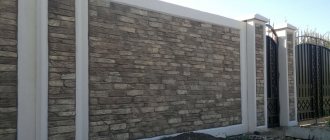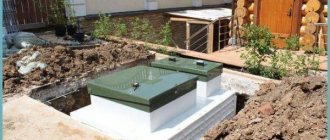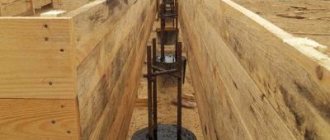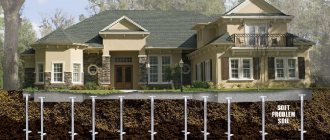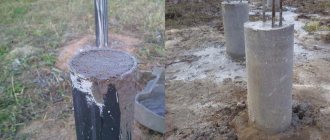The foundation is the basis of every residential building.
The operational characteristics of the building, its stability, strength and safety depend on its strength and reliability. After all, it bears the main load from the entire structure, which is why its competent construction is so important. The strip foundation is affordable and quite popular: it is often the choice when building bathhouses, private houses and garages. It is much more economical than its pile counterpart, but at the same time it is much more functional.
A strip foundation is ideally suited for the construction of dwellings with an actively used basement.
[contents]
Foundation requirements
Regardless of the main purpose of the future building, the requirements for a strip foundation must be strictly followed. This is dictated by building codes and regulations, which make it possible to provide high-quality and reliable support for the new building. The new concrete pour must meet a number of criteria:
- Strength. A proper strip foundation can withstand significant mechanical loads without crumbling or cracking.
- Sufficient trench depth.
- It is mandatory to have a high-quality drainage system that will ensure the outflow of water during heavy rains, melting snow and ice.
- The pour must contain a reinforced frame that prevents cracks from appearing in the foundation.
- In independent work on pouring a strip foundation, you should use only high-quality materials, and mix the cement mortar in the recommended proportions to give the concrete the proper consistency.
- To reduce losses of working solution, it is better to use formwork. During the pouring process, wooden contours ensure the tightness of the trench under the foundation and prevent leakage of the cementitious composition.
Only with full compliance with all building codes will home owners receive a high-quality foundation that provides reliable support for the structure. You can familiarize yourself with the basic provisions for construction and pouring in GOSTs and the legal framework. If necessary, you can watch a video on how to make a strip foundation with your own hands.
Preparatory work
Preparing a design for the future foundation
First of all: you will have to order a geodetic study from a design and construction organization to determine the type of soil, how capable it is of freezing in winter, the presence and depth of groundwater on the site. This company will also perform the necessary calculations and draw up a design for the construction of the future foundation.
If the planned construction is small in size, all the necessary measures can be done independently. To build a cottage or other large-scale structure, it is advisable to turn to professionals.
Preparation of materials
Typically, high-quality concrete of grade two hundred is used for such work. You can make the mixture yourself, or you can order it ready-made. The process is quite labor-intensive, which explains the heterogeneity of the base filled in individual portions.
The composition of concrete for the manufacture of strip base includes:
- cement, gravel and coarse sand in a standard ratio;
- clean sand (river) for arranging a pillow;
- 2-centimeter planed board for making formwork;
- wire for reinforcement and steel rod 8-12 mm in diameter.
Types of strip foundation
In the construction industry, there are several types of strip foundations. The pouring is assessed according to two groups of criteria: the depth of the cement mortar and the type of base. Based on the first group of criteria, the following types of foundation are distinguished:
- Concrete base without depth. Do-it-yourself shallow-depth strip foundations are used in regions where there is virtually no soft soil, and deepening is impossible due to the presence of rocky rocks.
- Base with medium depth. The most common strip foundation model is used on stable soils in regions with a comfortable climate.
The third type of foundation - with artificial burial - is used in regions with an unstable climate, on soil with a constant risk of surface erosion. This type of filling makes it possible to adequately protect the new structure from the effects of groundwater, from soil subsidence, and from the activation of karst voids. This type of filling is also preferred in regions equated to the far north.
Frosty winters and rapid melting of ice cause heaving of the soil, and consequently lead to instability and subsidence of the ground under buildings. You can learn how to properly fill one or another version of a strip foundation with your own hands from video tutorials on various web portals.
The second group of criteria is directly related to the specifics of installation construction work. Concrete strip can be arranged using several methods:
- In the form of a continuous strip or monolithic strip foundation.
- Modular blocks.
But the third type, the pile-strip foundation, has gained the most popularity. With this approach to construction, preliminary welding of a metal frame (made of reinforced iron) is used, onto which concrete is poured. This type of structure has particular strength, tensile strength, and can withstand very significant axial loads.
What are concrete pumps intended for - the advantages and disadvantages of this method of transporting the mixture
The most convenient way to transport any fluid substances is pipes. Agree to pump liquid faster and more conveniently than carrying it in buckets. They try to use pipeline transport wherever possible.
An example is that even the cheapest transportation of oil by sea by tankers is being replaced by laying pipes along the bottom. There is no need to compare it with transportation by rail or tank trucks.
This applies on a smaller scale to the construction site. It is easier to deliver the mixture to the concreting site via a concrete pipeline than in buckets or even using a conveyor belt.
To pump concrete, special units - concrete pumps - are used - we will talk about them further.
Advantages of using concrete pumps
Let's start with the advantages, thanks to which the speed of concreting, compared to other methods of supplying the mixture, increases almost three times (the video in this article below shows the effective operation of these units), and also improves the quality of the work.
- A continuous installation process can be ensured. Stopping concreting reduces the quality of the finished material, since the partially hardened mixture does not adhere well to the fresh, just prepared one.
- With the help of concrete pumps of appropriate power, the mixture can be easily conveyed to heights. If belt conveyors, when moving the mixture horizontally, can even exceed the characteristics of a concrete pump, then for its vertical delivery it is necessary to use special devices such as elevators.
Interesting. Although the idea of using bucket elevators - elevators at the construction of high-rise buildings is obvious, it is not being implemented, since other methods of delivering materials to heights are more effective.
- Delivery of concrete through pipes allows you to move a large volume in the shortest possible time. When using buckets, the speed is reduced due to the need to load concrete into them, as well as the low speed of the crane.
- To move the mixture using buckets, you need a mounted crane, the reach of which is limited. If, in addition, you need to additionally move along crane tracks, the delivery time increases even more. The concrete pump does not need it.
- Sometimes, for example, when the ceiling has already been installed, it is no longer possible to supply a bucket from above, but you can easily install a concrete pipeline.
- Concrete pipelines are compact and do not take up much space, unlike belt conveyors.
- Installing pipes is faster than installing conveyor sections.
- When moving the mixture through pipes, water loss is minimal (even through evaporation), this has a positive effect on the quality of concrete. This fact is especially important when there is a large distance between the place of preparation (or unloading) and the place of laying.
- Concreting using a concrete pump requires fewer construction workers than using other methods . Coupled with a reduction in work completion time, this reduces wage costs.
Due to these advantages, concrete pumps are used almost always when laying very large quantities of mixture is required. However, there are also some disadvantages.
Disadvantages of using concrete pumps
- This is not the cheapest construction equipment, so the cost of purchasing (or renting) it is still high.
- Installation of a concrete pipeline is required, which also takes time. The situation is solved with the help of hanging pipes on the boom, but their radius of reach is limited.
- If spot pouring of small places is required (for example, when installing prefabricated monolithic structures), then it is more profitable to use other methods of transporting concrete.
- Pump mechanisms and pipes, even those made of special materials using abrasion-resistant protective coatings, still wear out, especially when moving a mixture with solid aggregates that have abrasive properties.
As you can see, there are also disadvantages, so if the amount of work is small (for example, you need to pour a screed of small thickness), it is still more profitable to use other feeding methods.
Calculation of trench depth
After selecting the main construction parameters (location, preparing a drawing of the future structure and pouring model), it is necessary to correctly calculate the depth of the foundation for the house. The width of the pit being prepared also matters, but its parameters are most often standardized. Traditionally, for average regions with a stable climate, the dimensions of the strip foundation are 70 cm. However, a number of factors can change the calculation of the strip foundation:
- Soil type, its condition, presence of groundwater.
- Estimated weight of the future structure, axial load.
- Type of tape fill (modular, continuous model).
Insufficient trench depth can lead to a reduction in the life of the building and also cause premature failure of the foundation. Excessive thickness of the fill is the cause of irrational spending of financial resources. If difficulties arise with calculating the depth, it is better to seek help from a construction specialist who will professionally assess all risk factors. Also in practice, a convenient application is used - a strip foundation calculator.
Classification of concrete pumps by mobility
In addition to the fact that concrete pumps differ in the method by which the mixture is supplied, they are also divided by mobility.
Mobile concrete pumps
Most often they are mounted on a truck base. The concrete pump is driven directly through the power take-off shaft or through an intermediate hydraulic pump (hydraulic transmission).
Additionally, you can watch how a concrete pump works in the video below.
Self-propelled concrete pumps mounted on a tracked chassis are very rare. They are used in conditions where the construction site or the entrances to it make it difficult to move standard equipment. Such installations are delivered over long distances on trawls.
Almost always, mobile installations are equipped with a retractable, controlled boom with a concrete pipeline.
Its reach can reach up to 30 meters, and for some models based on special heavy-duty vehicles, even more. However, they can also be connected to stationary concrete pipelines already installed on the construction site.
There are models mounted on the basis of a concrete mixer truck (often called a mixer) as additional equipment. In this case, they combine the functions of transporting concrete from the place of its preparation and a device for laying it in formwork.
Stationary concrete pumps
Most of these units can be called conditionally stationary, since they still have some mobility. Typically mounted on a wheeled chassis that can be towed.
Preparation of materials and tools
For independent work, craftsmen will need the following set of tools:
- Shovels.
- Wooden pegs and rope for marking.
- Concrete mixer or metal container for mixing the solution.
- Metal reinforcement to strengthen the strip foundation.
- Wooden boards for formwork construction.
- Grinder and welding for the construction of a supporting structure in a trench.
- Sand, cement, gravel.
- Several pipes (metal, plastic) to create a high-quality drainage system.
You should also take care in advance to prepare personal protective equipment: a respirator, construction gloves. Step-by-step instructions for pouring a strip foundation with your own hands for a house (bathhouse, barn, gazebo) will be useful.
Concrete pump structures
Many principles are used to pump liquids - ejection, the use of centrifugal force, the use of membranes, etc. As is understandable, not all of them are suitable for pumping concrete.
In addition, if for many pumps it is important not only the pressure after it and the vacuum created at the inlet (suction or in other documents suction, lift), the mixture is supplied to the concrete pump directly to the intake. Therefore, the vast majority of existing pumps are of only three types - let’s look at them in more detail, noting the advantages and disadvantages of each.
Piston pump
This is one of the oldest and most common designs. Pistons moving in the cylinders capture and push out the moving medium as they move.
The concrete pump also works.
- Concrete from the mixer or transport vehicles enters the receiving hopper. Its capacity is selected to ensure a continuous process. For example, the consumption of the mixture is 10 m 3 per hour, and cars bringing 10 m 3 also arrive every hour. To ensure that there is no interruption in work, the capacity of the bunker will be 12-15 m3, so that there is no interruption in supply when transport is delayed.
- To ensure that the mixture in the bunker does not separate, it is usually equipped with an additional mixing device.
- The pump cylinder is connected to the receiver through a valve (gate); during the reverse stroke of the piston, it opens and a portion of the mixture enters it.
- When the piston reaches the rear extreme point, the gate connecting the cylinder with the hopper closes, another one opens, which previously blocked the exit to the concrete pipeline.
- When the piston moves forward, a portion of the mixture is pushed into the concrete pipeline.
Preparing the work site
The area designated for the construction of the foundation must be thoroughly cleared of debris and tree roots. The top layer of soil is removed. Next, using pegs and rope, the territory is marked, indicating the lines for pouring the concrete strip.
Pit preparation
The next step for the master is to prepare a trench for pouring the foundation. Based on the calculations carried out, they dig a pit of the proper depth and width. The walls and bottom of the trench are carefully leveled and compacted. Joints and corners are processed manually using a shovel.
Organization of the drainage system
High-quality drainage for a strip foundation is simply necessary, because reliable outflow of water during heavy rains, melting snow, and rising levels of underground flows depends on it. It is better to provide for the creation of optimal drainage at the preparatory stage, so as not to encounter problems with subsidence and erosion of the underlying soil in the future. Step-by-step instructions for beginners on organizing a drainage system on their own:
- The pipes selected for work are laid in the form of a continuous strip at the bottom of the trench.
- The master’s task is to position the pipelines in such a way that the concrete strip does not affect the surface of the pipes, and the sand cushion lies at the same level as the drainage system.
The ends of the pipes are led out to another area, thus ensuring a constant and high-quality outflow of storm water. A layer of sand is poured over the pipeline, creating a sand cushion.
What do experts recommend?
Sometimes you still need to listen to the advice of experienced masons and builders.
- Do not mix mortar from dirty building materials. Crushed stone and sand should not contain debris, soil or clay.
- The proportions of each component in different solutions may vary. One thing is constant: a portion of gravel or crushed stone is always twice as large as a portion of sand.
- The solution should contain 50% water by weight of cement.
- To make concrete mortar, wet sand is sometimes needed. When water is added to the concrete mixer, the amount of water that was spent on wetting the sand is taken into account. Otherwise, the finished concrete will turn out liquid.
- If the foundation is being built in cold weather, then heated water is used to make concrete. This way the concrete solution will set and harden faster.
- It happens that the concrete turns out thick. When it is poured into the formwork, they begin to compact it and constantly pierce it with a piece of reinforcement. Thus, the air that is in the concrete will be removed. Removing air is necessary to prevent air pockets from forming in the finished foundation.
- Tapping the formwork with a wooden beam also helps to remove air from poured concrete.
- It is recommended to remove the shields no earlier than a week after pouring the solution.
- Experts recommend insulating and waterproofing the foundation not only when pouring in layers, but always. Waterproofing and insulation increases the durability and strength of concrete.
Thus, for the construction of many buildings, a strip foundation is the best option.
Construction of formwork for pouring
The next stage of independent work is to install the formwork for the strip foundation with your own hands. A wooden frame that limits the contours of the trench can significantly reduce the loss of cement mortar. For this reason, the formwork should be assembled from smooth wooden boards, being careful not to leave gaps or holes in the body.
The height of the side plates of the formwork should exceed the depth of the pit by 5-10 cm so that the working composition does not spill onto the surface of the adjacent soil. Be sure to install horizontal crossbars, which give additional strength to the structure.
Problems that may arise when laying with concrete pumps
Although laying the mixture using concrete pumps is easier and faster than performing the same work without it, you need to take into account some features of using these mechanisms.
- The increased speed of laying the mixture can lead to the formation of cavities inside the monolith, especially if a fine mesh is used for reinforcement. Therefore, you need to ensure that the concrete is evenly distributed.
- If compaction is carried out with surface rather than deep vibrators, then it is necessary not to get carried away with large volumes of the laid mixture. Be sure to compact each layer.
- It is necessary to carefully fix the reinforcement cage; a powerful flow of mixture from the concrete pipeline can displace the reinforcement elements and embedded parts.
- When working with a high-capacity concrete pump, it is difficult for one or even two builders to hold the flexible end of the concrete pipeline. You should give preference to a boom or at least hang the pipes on a crane.
- Plugs formed in the concrete pipeline can damage it and the pump mechanisms. If it begins to form, try reversing the pump (if possible) for a short time. Otherwise, disconnect the area and clean the pipes by hand.
- In order not to contribute to the formation of traffic jams, do not take long breaks in work; during this time, some of the concrete may set. Make sure that all builders (sometimes it becomes necessary to leave, even for a short time) can be replaced immediately.
- At the end of concreting (or changing), both the pump itself and the concrete pipeline pipes must be thoroughly washed.
Knitting reinforcement for the foundation
Reinforcement of a strip foundation is mandatory to strengthen the supporting structure. This approach can significantly increase the tensile strength of the concrete base. The metal frame is welded in advance, and before pouring the frame is lowered into a trench.
